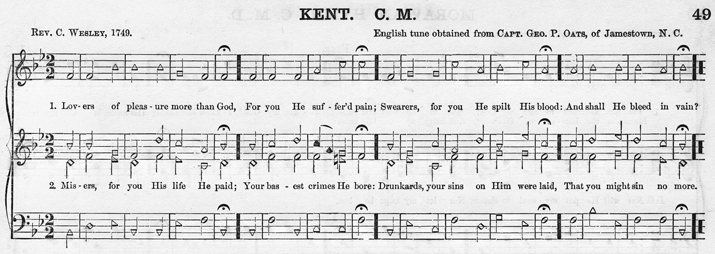
Shape-note singing is a form of American choral music developed in the early nineteenth century and still sung in sections of the southeastern United States. Shape-note singing is also known as "fasola" singing, after the musical syllables, fa, sol, and la, or "sacred harp" singing, a reference to The Sacred Harp, one of many compilations of shape-note music. The term "shape-note" comes from the system of notation used in this music. Instead of using standard notation, in which musical notes have an oval shape, shape-note music assigns a unique shape to a note to indicate its pitch on the staff. Thus, a triangle represents the pitch fa; a circle, sol; a square, la; and a diamond, mi.
Shape-note singing spread rapidly throughout the South. Such was its popularity that between 1801 and 1855 at least 38 shape-note tune books were published. These tune books usually included rudiments of music theory and some instructions on the art of singing. The majority of compositions in each book were hymns and other religious songs, but secular selections included love songs and patriotic tunes. Among the most popular shape-note tune book of the antebellum period was The Southern Harmony, compiled by William Walker (1809-75) of South Carolina, one of the most prominent of the southern shape-note singing teachers. Sources for songs in the book included hymn tunes composed by Walker, folk hymns already familiar to many singers, and white spirituals, or sacred texts set to secular folk melodies.
As in other southern states, shape-note music took hold in North Carolina, and North Carolinians contributed to the shape-note tradition. William Hauser (1812-80), born and raised near Bethania in Forsyth County, compiled The Hesperian Harp (1848), one of the largest of the shape-note tune books. The tradition of annual shape-note singings also developed in North Carolina with the dedication of the Etowah Baptist Church in 1909 in Henderson County. Participants initially used The Southern Harmony but eventually switched to The Christian Harmony. The annual singing became so popular that in 1952 it moved from the church to the Etowah Elementary School. The event is traditionally held twice a year, on the first Sunday in May and the first Sunday in September. Singing begins in the morning and, after a break for lunch, resumes in the afternoon.